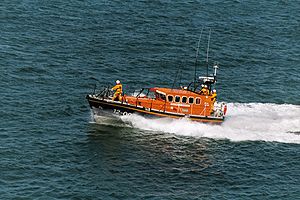- Mersey class lifeboat
-

12-007 RNLB Spirit Of DerbyshireClass overview Name: Mersey Class Operators:  Royal National Lifeboat Institution
Royal National Lifeboat InstitutionPreceded by: Rother Class Cost: £350,000 Built: 1987–1993 In service: 1988– Completed: 38 Retired: 1 General characteristics Displacement: 14 t (14 long tons) Length: 11.62 m (38.1 ft) Beam: 3.81 m (12.5 ft) Draught: 1.02 m (3.3 ft) Propulsion: 2 × 280 hp (210 kW) Caterpillar 3208T diesel engines Speed: 16 knots (18 mph; 30 km/h) Range: 140 nmi (260 km) Endurance: 10.25 hours approx. at cruising speed Capacity: 43 survivors (self-righting up to 21) Complement: 6 Mersey class lifeboats are all-weather lifeboats operated by the Royal National Lifeboat Institution (RNLI) from stations around the coasts of Great Britain and Ireland. They are capable of operating at up to 17 knots (31 km/h) and can be launched from a carriage.
The class name comes from the River Mersey which flows into the Irish Sea in north west England.
Contents
History
During the 1960s and 1970s the RNLI introduced fast lifeboats capable of considerable greater speeds than the 8 knots (15 km/h) of existing designs. The first of these were only able to be kept afloat as their propellers would be damaged if launched using a slipway or carriage. In 1982 the steel-hulled Tyne Class came into service which could be launched down a slipway but weighed 25 tons so was not suitable for being moved across a beach on a carriage. The answer was to build a smaller boat with an aluminium hull, which became the Mersey Class.[1]
The first, unnamed, Mersey was built in 1986 and undertook trails during 1987 and 1988. It was then taken out of service and sold the following year. It was working as a trip boat in Westport, County Mayo in 2008 carrying the name Spirit. Two more boats were built in 1988, with the first one to take up active service going to Bridlington Lifeboat Station the following year.[2]
In 1989 12-11 Lifetime Care was built with a fibre-reinforced composite (FRC) hull. Boats built in 1990 continued to use aluminium but from 1991 FRC became the standard hull material.[3][2]
Description
The Mersey is designed to be launched from a carriage, but can also lie afloat or be slipway launched when required. Its propellers are fully protected from damage when launching or in shallow water by partial tunnels and two bilge keels. Its low height can be further reduced by collapsing its mast and aerials which then allows it to be stored in a boathouse. A sealed cabin gives it a self-righting ability.
Power comes from two Caterpillar 285hp turbo-charged engines. It carries 1,110 litres (290 USgal) of fuel to give it a range of 240 nautical miles (440 km). It has a crew of six and can carry a X Boat inflatable which it can deploy at sea. Its survivor compartment can carry 43 people, but more than 21 prevents self-righting should the boat capsize.[3][4]
Fleet
ON Op. No. Name In service Station 1119 – – 1987–1988 Sold 1989 1124 12-001 Peggy and Alex Card 1988– Relief fleet 1125 12-002 Sealink Endeavour 1987– Hastings 1161 12-003 Doris M Mann of Ampthill 1990– Wells 1162 12-004 Royal Shipwright 1990– Relief fleet [5][6] 1163 12-005 Lady of Hilbre 1990– Hoylake 1164 12-006 Andy Pearce 1990– Llandudno 1165 12-007 Spirit of Derbyshire 1990– Ilfracombe 1166 12-008 Lincolnshire Poacher 1990– Skegness 1167 12-009 The Princess Royal (C.S. No. 41) 1990– St Ives 1168 12-010 Lily and Vincent Anthony 1991– Pwllheli 1148 12-11 Lifetime Care 1989– Relief fleet 1169 12-12 Marine Engineer 1991– Bridlington 1170 12-13 Keep Fit Association 1991– Filey 1171 12-14 Ann and James Ritchie 1991– Ramsey 1172 12-15 Frank and Lena Clifford of Stourbridge 1992– New Quay 1173 12-16 Grace Darling 1991– Seahouses 1174 12-17 Kingdom of Fife 1991– Anstruther 1175 12-18 Fanny Victoria Wilkinson and Frank Stubbs 1991– Scarborough 1176 12-19 The Four Boys 1991– Amble 1177 12-20 Leonard Kent 1991– Margate 1178 12-21 Margaret Jean 1992– Exmouth 1181 12-22 Ruby Clery 1992– Peel 1182 12-23 Robert Charles Brown 1992– Swanage 1183 12-24 Lil Cunningham 1992– Rhyl 1184 12-25 Bingo Lifeline 1992– Relief fleet 1185 12-26 Moira Barrie 1992– Barmouth 1186 12-27 Pride and Spirit 1992– Dungeness 1187 12-28 Mary Margaret 1992– Relief fleet 1188 12-29 Eleanor and Bryant Girling 1993– Newcastle 1189 12-30 Her Majesty The Queen 1993– St Annes 1190 12-31 Doris Bleasdale 1993– Clogher Head 1191 12-32 Joy and Charles Beeby 1993– Berwick-upon-Tweed 1192 12-33 Fisherman's Friend 1993– Relief fleet 1193 12-34 Freddie Cooper 1993– Aldeburgh 1194 12-35 Inchcape 1993– Arbroath 1195 12-36 Royal Thames 1993– Eastbourne 1196 12-37 Sylvia Burrell 1993– Girvan 'ON' is the RNLI's Official Number; 'Op. No.' Is the operational number carried on the hull. Stations given correct in 2009 unless otherwise stated.[2]
References
- ^ Wake-Walker, Edward; Deane, Heather and Purches, Georgette (1989). Lifeboat! Royal National Lifeboat Institution. Shepperton: Ian Allan. pp. 38–43. ISBN 0-7110-1835-9.
- ^ a b c Denton, Tony (2009). Handbook 2009. Shrewsbury: Lifeboat Enthusiasts Society. pp. 30–35.
- ^ a b Wake-Walker, Edward (2008). The Lifeboats Story. Stroud: Sutton Publishing. p. 69. ISBN 0-7509-4858-6.
- ^ "Mersey". The Fleet. RNLI. http://www.rnli.org.uk/what_we_do/lifeboats/current_lifeboats/lifeboat_detail?articleid=44196. Retrieved 2010-12-02.
- ^ Royal Shipwright (Relief)
- ^ New Lifeboat for Cromer
External links
Classes of Royal National Lifeboat Institution lifeboats Operational fleet All-weather lifeboatsInshore lifeboatsSmall inflatablesExperimental lifeboatsShannonHistoric lifeboats Up to 10 knotsBarnett • Clyde • Liverpool • Oakley • Peake • Rother • Solent •Above 10 knotsArun • Brede • Thames • WaveneyInshore lifeboatsA Class: Hatch • McLauchlan • B Class: Atlantic 21 • C Class: Zodiac IV • D Class: EA16Experimental lifeboatsKeith Nelson • MedinaRoyal National Lifeboat Institution Categories:- Classes of RNLI lifeboat
Wikimedia Foundation. 2010.




